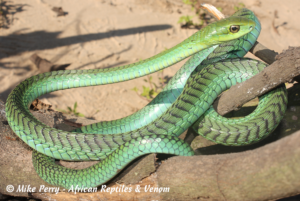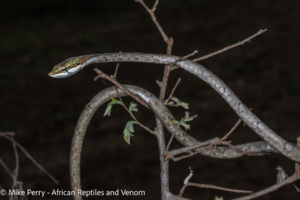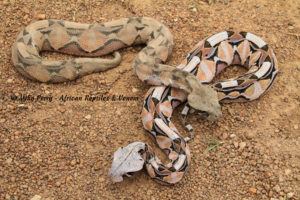DEADLY BUT NOT DANGEROUS
Many snakes have deadly venom but are not dangerous. Here we use the word “dangerous” in the context of something that is known to regularly cause morbidity (tissue damage or systemic effects), or mortality (death).
In this group of ‘deadly but not dangerous’ snakes, almost no bites are recorded. This is because these snakes are either: secretive, have a limited distribution, have habits that prevent them coming into contact with humans, or, like most snakes, they tend to flee if approached. In rare cases where bites are recorded, they are usually on snake handlers or snake catchers.
Boomslang
 The Boomslang is a great example – it has a deadly haemotoxic venom that affects the clotting abilities of the blood, causing “Bleeding Syndrome”. Without specific Boomslang antivenom the chance of dying is almost guaranteed, but there are very few bite records for Boomslang.
The Boomslang is a great example – it has a deadly haemotoxic venom that affects the clotting abilities of the blood, causing “Bleeding Syndrome”. Without specific Boomslang antivenom the chance of dying is almost guaranteed, but there are very few bite records for Boomslang.
This snake is common and widespread throughout most of South Africa (except sparsely vegetated dry regions) and these snakes often observed by people, but bite cases are almost unheard of.
In rare cases where bites are recorded, they are usually on snake handlers or catchers. Boomslang live in trees and there is a good chance you have passed a few when walking in the field. If a Boomslang detects you, as you walk by, it will freeze, hoping you don’t see it, which often you won’t. But if you approach a Boomslang and disturb it will do its best to get away, which they do at great speed. If you follow and continue to harass the snake, at close quarters it will likely defend itself and try to bite you.
In conclusion, the Boomslang has a potent and deadly venom, but statistically, it not dangerous.
Vine Snake
 The Vine Snake, just like the Boomslang, also has lethal haemotoxic venom. Again bites are almost never recorded. Vine Snakes have a wide range occurring throughout eastern KZN (east of the escarpment) and over most of the old Transvaal provinces, except for parts of Gauteng. In some places, like Zululand in northern Kwazulu-Natal, Vine snakes are very common.
The Vine Snake, just like the Boomslang, also has lethal haemotoxic venom. Again bites are almost never recorded. Vine Snakes have a wide range occurring throughout eastern KZN (east of the escarpment) and over most of the old Transvaal provinces, except for parts of Gauteng. In some places, like Zululand in northern Kwazulu-Natal, Vine snakes are very common.
If you have ever walked in a wooded savannah or forest, there is a good chance you have walked past Vine Snakes without knowing it. They are well camouflaged and will freeze if they see danger, and like the Boomslang, they prefer to flee if disturbed and will only try bite is harassed or grabbed.
In conclusion the venom of a Vine Snake is severely lethal but, statistically, the Vine Snake is not dangerous.
Gaboon Adder
 The Gaboon Adder is another contender in the “Deadly but not Dangerous” category. Statistically almost no bites are recorded throughout its extensive range. The Gaboon Adder lives in or near tropical forest and can be found from northern Kwazulu-Natal into Mozambique and throughout most of equatorial Africa. – and yet few bites are known. How can this be possible?
The Gaboon Adder is another contender in the “Deadly but not Dangerous” category. Statistically almost no bites are recorded throughout its extensive range. The Gaboon Adder lives in or near tropical forest and can be found from northern Kwazulu-Natal into Mozambique and throughout most of equatorial Africa. – and yet few bites are known. How can this be possible?
The reasons may be varied but Gaboon Adders are generally placid and they rely so strongly on their amazing camouflage that they will often keep dead still even if you are standing next to the snake, or happen to walk by, almost stepping on the snake.
There are anecdotal reports of Gaboon Adders being totally unresponsive even when touched or gently lifted – but please don’t test this theory.
Unlike other species of African adder, The Gaboon Adder has a particularly dangerous venom which consists of Cytotoxins, Haemotoxins and unusual Cardiotoxins. A bite from a Gaboon adder is a very serious matter.
Green Mamba
 The Green Mamba’s venom is similar to a black mamba’s venom – potent and deadly. But, the Green Mamba is not dangerous, statistically.
The Green Mamba’s venom is similar to a black mamba’s venom – potent and deadly. But, the Green Mamba is not dangerous, statistically.
In Southern Africa the Green Mamba is found in coastal forest along the entire Kwazulu-Natal coastal strip and into Mozambique. Further north the Green Mamba occurs in tropical forest or forest-savanna mosaic into East Africa. A population occurs around the eastern escarpment of Zimbabwe.
Although wide-ranging, very few bites are known. Most known bites are on snake handlers or catchers. If you have ever been to coastal Kwazulu-Natal you have probably walked past, or under, a green mamba. Green Mamba’s are active during the day. These snakes are timid, shy, well-camouflaged, and are hardly ever seen. They live in trees, rarely coming to the ground.
Conclusion
Many people wrongly assume snakes are programmed to attack and bite humans. Because of this, snakes are usually killed on sight. The actual truth is different. Snake are very afraid of anything taller than themselves– anything larger than a prey item is considered a predator and the snake will try remain undetected, or it will get away as fast as it can. There is every chance you have walked past venomous snakes without knowing it, and without being attacked.
Look out for our next article on dangerous snakes that are not deadly.
